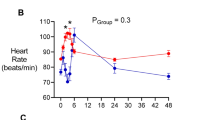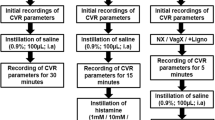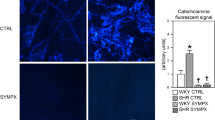Abstract
IN the majority of investigations concerning the mechanism of retention of circulating noradrenaline by tissues, the amine has been administered by intravenous injection. Noradrenaline itself, as well as a wide variety of physiological and pathological conditions, are known to exert profound effects on the flow of blood through tissues. It is important, therefore, to establish the effect of changes in flow rate on the uptake of circulating noradrenaline or that liberated by sympathetic nerve stimulation. The evidence in the literature on this point is conflicting. It has been shown that the greater the flow of blood through the organ, the greater is the amount of noradrenaline in the venous effluent following stimulation of the post-ganglionic sympathetic nerves to spleen1–3, intestine4 and skeletal muscle5. On the other hand, spontaneous changes in flow rate have been reported to be without effect on the retention of noradrenaline by the perfused heart6 and the perfused spleen7. Consequently, we have examined the effect of different, controlled flow rates on the uptake of tritiated noradrenaline by the perfused spleen.
This is a preview of subscription content, access via your institution
Access options
Subscribe to this journal
Receive 51 print issues and online access
$199.00 per year
only $3.90 per issue
Buy this article
- Purchase on Springer Link
- Instant access to full article PDF
Prices may be subject to local taxes which are calculated during checkout
Similar content being viewed by others
References
Brown, G. L., and Gillespie, J. S., J. Physiol. (Lond.), 138, 81 (1957).
Blakeley, A. G. H., Brown, G. L., and Ferry, C. B., J. Physiol. (Lond.), 167, 505 (1963).
Hertting, G., and Schiefthaler, T., Arch. Exp. Path. Pharmak., 246, 13 (1963).
Brown, G. L., Davies, B. N., and Gillespie, J. S., J. Physiol. (Lond.), 143, 41 (1958).
Carlsson, A., Folkow, B., and Häggendal, J., Life Sciences, 3, 1335 (1964).
Lindmar, R., and Muscholl, E., Arch. Exp. Path. Pharmak., 247, 469 (1964).
Gillespie, J. S., and Kirpekar, S. M., J. Physiol. (Lond.), 176, 205 (1965).
Fischer, J. E., Horst, W. D., and Kopin, I. J., Brit. J. Pharmacol., 24, 477 (1965).
Iverson, L. L., Brit. J. Pharmacol., 21, 523 (1963).
Iverson, L. L., J. Physiol. (Lond.), 175, 71P (1964).
Iverson, L. L., quoted by Zaimis, E., J. Physiol. (Lond.), 177, 35P (1965).
Potter, L. T., Cooper, T., Willman, V. L., and Wolfe, D. E., Circ. Res., 16, 468 (1965).
Hertting, G., Proc. Sec. Intern. Pharm. Meeting, 3, 277 (1965).
Wurtman, R. J., Kopin, I. J., Horst, D., and Fischer, J. E., Amer. J. Physiol., 207, 1247 (1964).
Johnson, P. O., Statistical Methods in Research, 62 (Prentice Hall, New York, 1949).
Author information
Authors and Affiliations
Additional information
A corrigendum to this article is available online at https://doi.org/10.1038/211674b0.
Rights and permissions
About this article
Cite this article
PATON, D., GILLIS, C. Effect of Altered Perfusion Rates on the Retention of Noradrenaline by the Spleen. Nature 208, 391–392 (1965). https://doi.org/10.1038/208391a0
Issue Date:
DOI: https://doi.org/10.1038/208391a0
This article is cited by
-
The influence of the rate of perfusion on the kinetics of neuronal uptake in the rabbit isolated heart
Naunyn-Schmiedeberg's Archives of Pharmacology (1978)
-
Effects of flow-stop on the metabolism of noradrenaline released by nerve stimulation in the perfused spleen
Naunyn-Schmiedeberg's Archives of Pharmacology (1973)
Comments
By submitting a comment you agree to abide by our Terms and Community Guidelines. If you find something abusive or that does not comply with our terms or guidelines please flag it as inappropriate.



